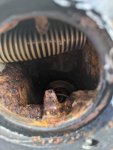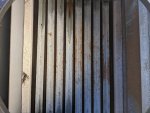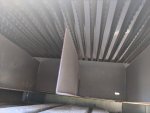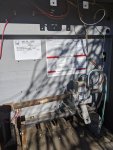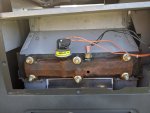I have a Raypak C-R336A-EN-X ASME heater on my 30k gallon IGP. This is a Raypak Digital 336, ASME, commercial with Cupro-Nickel Heat Exc. I've only owned the pool for 2 seasons so I don't know the age of the heater. I had a slow leak at the outlet joint at the end of the swim season and I just took it apart to repair the connection. I noticed quite a lot of corrosion in the cast iron header when I removed the outlet pipe. I've noticed similar corrosion in the cast iron return header on the opposite end of the heat exchanger. I've also seen rust flakes come out of the return jets into the pool. So obviously the headers (at least) are corroding. My question is whether it is worth it to buy replacement cast iron headers for both ends of the heat exchanger (probably ~$500+ in parts based on quick online search)? Or is it time to replace the whole heater? I'm fairly confident I could replace the headers myself with the right parts, but I'm not sure whether other parts of the heater will start to fail in the near future. Anyone have experience with repair of this heater?
Raypak Heater Repair or Replace
- Thread starter ghotihook
- Start date
You are using an out of date browser. It may not display this or other websites correctly.
You should upgrade or use an alternative browser.
You should upgrade or use an alternative browser.
- Jul 21, 2013
- 53,330
- Pool Size
- 35000
- Surface
- Plaster
- Chlorine
- Salt Water Generator
- SWG Type
- Pentair Intellichlor IC-60
Post pics of the guts of the heater for folks to give you a visual assessment.
@Pool Clown @ps0303 @swamprat69
@Pool Clown @ps0303 @swamprat69
Pool Clown
In The Industry
Take the door off the heater and snap some pics of it to get an idea how its aging. And post the serial number, we can tell you how old the heater is.
- Jul 21, 2013
- 53,330
- Pool Size
- 35000
- Surface
- Plaster
- Chlorine
- Salt Water Generator
- SWG Type
- Pentair Intellichlor IC-60
Ok, I'll take some pics. SN is 1609429027.
Your heater was manufactured in September 2016 and is 4 years old.
Pool Clown
In The Industry
With normal wear and tear, exposure, and maintenance, you can expect to see at least 10 years from a heater.
- Oct 25, 2015
- 5,200
- Pool Size
- 25000
- Surface
- Plaster
- Chlorine
- Salt Water Generator
- SWG Type
- CircuPool RJ-60 Plus
I've seen a lot of Raypak heaters 5-10 years old installed in our area that appear to have a lot of rust inside the cabinet under the heater tubes and burner. If you have this I'd replace these parts as well. Exterior seems to hold up well. I don't see this as much in other brands similar age that use the coiled tube design. This is odd to me since experts here generally favor Raypak. Maybe a more recent design change? Or maybe I just happen to see more that the owner doesn't do good water balance. Or maybe its something to do with my S Florida weather. I'm not a service tech but have a lot of friends that are real estate agents and they often ask for my opinion when home inspections reveal pool equipment issues. If it were me, I'd inspect the tubes and any other parts that look like its close to failure. Then see if the cost of the parts is less than half the cost of a new heater if you're capable of repairing yourself. It probably is and if so, I'd replace it. Sounds like the prior owner may not have paid much attention to water chemistry. Keep within TFP recommendations in the future and you should get at least 5, maybe 10 years more out of it.
Chris
Chris
Attaching pictures. Overall the condition looks good to me. Not much rust other than the cast iron headers. You can see the rust inside the inlet/outlet header and the opposite side return header is rusty too. I'm leaning towards replacing the headers and calling it good. Advice?
Attachments
Any recommendations of where to buy parts and what parts to buy? I assume both cast iron headers. Do I need any gaskets or anything like that? Also what's the best way to connect to the PVC to the cast iron outlet and inlet flanges? Thanks, appreciate the feedback.
@Pool Clown @ajw22 @setsailsoon
@Pool Clown @ajw22 @setsailsoon
Last edited:
- Jul 21, 2013
- 53,330
- Pool Size
- 35000
- Surface
- Plaster
- Chlorine
- Salt Water Generator
- SWG Type
- Pentair Intellichlor IC-60
Looks pretty good to me. I would assume the prior owner did not do a good job with water chemistry which may have damaged the headers. The question is if the heat exchanger is solid. Before you buy the new parts I would pull off the headers and see what can be seen in the heat exchanger. If it looks good then buy new headers and put it back together.
Last edited:
- Oct 25, 2015
- 5,200
- Pool Size
- 25000
- Surface
- Plaster
- Chlorine
- Salt Water Generator
- SWG Type
- CircuPool RJ-60 Plus
I concur with Allen. It looks better than most Raypak heaters I see in my area but I would inspect after headers are off as he recommended. I've had good experience with these people. Not always the cheapest but no the most expensive either. They are an authorized rep for many of the parts they sell.
I hope this helps.
Chris
I hope this helps.
Chris
Thanks guys, this helps a lot. Out of curiosity, what specific water chemistry imbalance would lead to the corrosion in the headers?
- Jul 21, 2013
- 53,330
- Pool Size
- 35000
- Surface
- Plaster
- Chlorine
- Salt Water Generator
- SWG Type
- Pentair Intellichlor IC-60
Thanks guys, this helps a lot. Out of curiosity, what specific water chemistry imbalance would lead to the corrosion in the headers?
Low pH below 6.8.
Is there a tab chlorinator after the heater?
Low pH below 6.8.
Is there a tab chlorinator after the heater?
There was but I eliminated it this season when I made some other plumbing changes.
- Jul 21, 2013
- 53,330
- Pool Size
- 35000
- Surface
- Plaster
- Chlorine
- Salt Water Generator
- SWG Type
- Pentair Intellichlor IC-60
Was there a check valve between the heater output and the chlorinator?
The backflow of acidic water when the pump is off from the chlorinator could have damaged the heater.
The backflow of acidic water when the pump is off from the chlorinator could have damaged the heater.
- Oct 25, 2015
- 5,200
- Pool Size
- 25000
- Surface
- Plaster
- Chlorine
- Salt Water Generator
- SWG Type
- CircuPool RJ-60 Plus
There are quite a few documented cases where this can ruin a heater in way less than a year.
I don't think there was any check valve. Either way it's gone now so hopefully replacing the cast iron headers will keep the heater going for a long time. What's the best way to connect the cast iron inlet/outlet flanges with the PVC? That joint was leaking which is what started my investigation into the heater to begin with.
- Jul 21, 2013
- 53,330
- Pool Size
- 35000
- Surface
- Plaster
- Chlorine
- Salt Water Generator
- SWG Type
- Pentair Intellichlor IC-60
Page 46 in http://cdn.globalimageserver.com/FetchDocument.aspx?ID=c404f1c5-ac50-4209-9457-56246d010b20 says the cast iron header was discontinued in December 2019 and replaced by bronze headers. It is not clear how the connection is made.
@ps0303 @Pool Clown @swamprat69 ideas?
@ps0303 @Pool Clown @swamprat69 ideas?
- Oct 25, 2015
- 5,200
- Pool Size
- 25000
- Surface
- Plaster
- Chlorine
- Salt Water Generator
- SWG Type
- CircuPool RJ-60 Plus
For the connection I would order a set of flange connectors. They usually come with gaskets and the flange nuts. You can find them online for $30-$50. CMP makes an after market version that is a little less expensive for most heaters.
Chris
Chris
Thread Status
Hello , This thread has been inactive for over 60 days. New postings here are unlikely to be seen or responded to by other members. For better visibility, consider Starting A New Thread.


